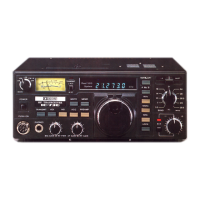SECTION 3 CIRCUIT DESCRIPTION
3·1
RECEIVING CIRCUITS
3·'
• 1 RF CIRCUITS
The receiving
signal
from
the antenna
is
fed
from
P3
of
the
LPF
unit
to
J2·1, where frequencies
less
than 3.5MHz
are
attenuated about 4Od8 by a
High-Pass
filter. This
filter
reduces
intermodulation
by
strong
BC
signals.
The
signal
is
usually fed
to
03
directly through the contacts
of
RLl.
The
set
employs the OFM (Direct
Feed
Mixer) system at
the
front
end,
to
get wide dynamic
range.
When
the PREAMP switch on the
front
panel
is
in the
ON
position, the
signal
is
fed
to
the preamplifier. The pre-
amplifier, consisting
of
01
and
02,
is
designed
to
provide
the gain
of
about 10dB and the intercept
point
of
26dBm
on the entire band.
To the preamplifier, power source
(13.8V)
is
always applied
regardless
if
the preamplifier
is
turned on
or
off.
When
the
PREAMP switch
is
pushed in, the emitter
of
03
is
grounded
through the switch
and
RL 1
is
actuated in the
receive
mode,
as
R8V
is
applied
to
the
base
of
03
through R4. In the
transmit mode
or
when
08
is
turned on
as
the
TRV
signal
is
applied
to
its
base,
the
bias
voltage
is
not
applied
to
03
and
RL 1
is
not
actuated
even
if
the PREAMP switch
is
pushed in.
05
is
turned on in the transmit mode and shunts the re-
ceiver input line
to
ground
to
prevent
RF
feedback.
The
signal
passed
03
is
fed
to
a
band-pass
filter
which
is
selected
by
the band switching signal sent from the BAND
switch through the
PRE·MIX
unit.
The
band-pass
filters
are
provided
for
each
band,
and
one
is
selected
for
the band
of
operation
by
turning ON the
diodes located at the
input
and
output
circuits
of
the
filter.
These
filters
have
about 2dB insertion
loss
res-
pectively.
The
signal
passed
the
band-pass
filter
is
fed
to
the 1st mixer
consisting
of
04
•
07
(Doubly Balanced Mixer). This
OBM
has
a +18dBm intercept
point
and 6dB insertion
loss.
The 1st Local Oscillator functions at the operating fre-
quency plus 1st IF (39.7315MHz) frequency.
It
is
fed from
the
BPF
unit
through J6.
This
1st
LO
is
changed
with
1 kHz
steps
and its frequency
range
for
each
band
is
as
follows;
BAND
3.5MHz
7.0MHz
10.0MHz
14.0MHz
18.0MHz
1st LO FREOUENCY
43.1319MHz
""
43.8315MHz
46.6315MHz
""
47.3315MHz
49.6315MHz""
SO.3315MHz
53.6315MHz
""
54.3315MHz
57.6315MHz
""
58.3315MHz
3-1
21.0MHz
24.5MHz
28.0MHz
28.5MHz
29.0MHz
29.5MHz
60.6315MHz
""
61.3315MHz
64.1315MHz "" 64.8315MHz
67.6315MHz
""
68.3315MHz
68.1315MHz
""
68.8315MHz
68.6315MHz
""
69.3315MHz
69.1315MHz
""
69.8315MHz
The center frequency
of
the 1st IF
is
varied 39.7305MHz-
39.7315MHz due
to
the 10Hz step tuning.
The 1st
IF
signal
converted at the 1st mixer
is
fed
to
the
monolithic crystal
filter
FI2 through
020
transmit/receive
switching diode, then fed
to
the 1st IF amplifier
06.
FI2
has
a
pass
band
of
15kHz
at
-3dB
points.
The 1
st
IF ampl ifier
06
is
aMOS F ET,
and
an
AGC voltage
is
applied
to
its 2nd gate. The attack time constant
is
determined by R36 and C67.
C81
prevents VH F parasitic
oscillation.
The amplified 1
st
I F
signal
is
fed
to
F
11
through 021
transmit/receive switching diode.
Fll
is
the
same
as
F12,
and
totally
the 2nd
image
rejection ratio
is
more than
SOdB.
The 1st IF signal
passed
Fll
is
then fed
to
the 2nd IF
unit.
3
-1
- 2 SECOND
IF
CIRCUITS
The 2nd IF signal fed
from
the
RF
unit
is
input
to
J2 and
fed
to
the Noise
Amplifier
and Noise Blanker
gate
circuits.
The
signal
(39.7315MHz)
is
amplified with
01
and
02,
dual
gate
MOS
FETs,
and
IC1, high gain amplifier with AGC.
The amplified signal
is
detected by
014
and then fed
to
IC2, voltage comparator
and
noise
pulses
are
detected.
016
genarates
the reference voltage, 1.2V,
for
IC2.
015
shunts over-voltage
to
prevent long delay-times.
A part
of
the detected
signal
from
014
is
used
for
the AGC
of
IC2. The detected
signal
is
fed
to
the
base
of
07
through
R42.
When
the detected voltage
exceeds
0.6V,
07
is
turned
ON
which turns
08
ON
as
well. 2.5V
is
usually applied
to
pin 3
of
IC2. This voltage
is
increased
when
08
turns ON,
with
time constant
of
R34
and
C42 (attack-time), This
provides the
AGC function. This time constant (attack·
time)
can
be
changed by the NB WIDTH switch
(S4
on the
MAl
N
unit).
When
it
is
set
at the
WI
DE
position, the time
constant
is
determined by R46 and C42. The release-time
of
the AGC
is
determined by R34, R38, R47 and C42.
Average
voltage at pin 2
of
IC2 will
be
0.6V due
to
the
AGC function. Only when the detected voltage
exceeds
1.2V
caused
by a noise pulse, pin 3
output
terminal
of
IC2
puts
out
lV
pulse,
and
it
turns ON the NB
gate
switch
03.
The
NB
gate
circuit
is
composed
of
020,
021
and
024,
and
usually
020
and 021
are
turned
ON
and
024
is
OFF
by the
reverse
voltage (6.6V) applied
to
the cathode.
When
OJ
is
turned
ON
by
a noise pulse,
024
is
turned ON
and
for
free
by
RadioAmateur.eu

